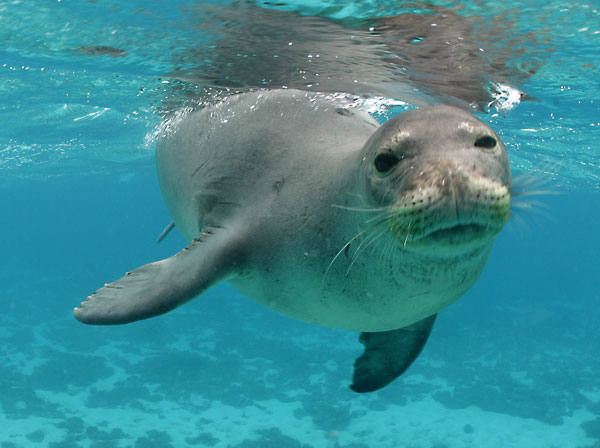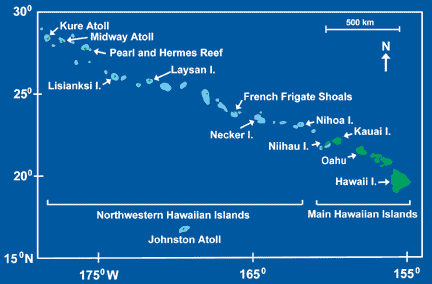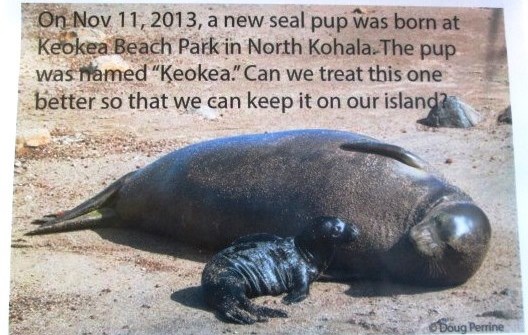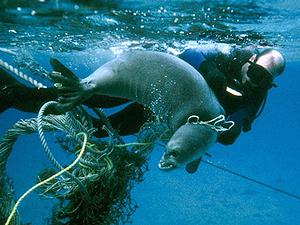Most Dangerous Vacation for the Hawaiian Monk Seal
Written by Josh Salinas
A majority of seals live in the cold climate areas of the ocean, however Hawaiian Monk Seal's live in the tropical Northwestern Hawaiian Islands in the middle of the Pacific Ocean. (Pictured below) In recent years humans have moved into many of the coastal habitats that these animals used to visit regularly. Monk seals have also been victims of fisheries, and usually killed due to accidental by-catch and not the targeted hunted species. Sharks are the seals number one predator, when they are not on the safety of the coastal shore. An average life span for a Hawaiian Monk Seal is between 25-30 years and weighs between 500-600 pounds.
 |
| https://circleoflife.wikispaces.com/Hawaiian+Monk+Seal |
The Hawaiian monk seal is one of the most endangered marine mammals in the world. Since the 1950's its population has dropped to about 1,300 animals and is continuing to decline. Scientists estimate Monk Seal populations will likely drop below 1,000 within the year of 2015.
Monk seals in the Northwestern Hawaiian Islands are dying of starvation, lack of food, drowning from abandoned fishing gear, predator sharks, and disease. Pups have only about a one-in-five chance of surviving to adulthood.
The Endangered Species for the Hawaiian Monk Seal was approved on August 22, 2007. The final plan was approved by the regional director, and the Hawaiian Monk Seal was listed as endangered.
The newly born seal pup "Keokea," (Pictured above) was born at Keokea Beach Park in North Kohala. (Pictured above) The Hawaiian Monk Seal lived a short life span of less than eight months due to a large fishing hook that was swallowed. (Youtube video link below)
 |
| https://youtu.be/PhZa8Sp_Cpc?t=1m4s |
Hawaiian Monk Seals are protected under the Endangered Species Act, the Marine Mammal Protection Act, and the state law in Hawaii.
The National Oceanic and Atmospheric Administration have a recovery strategy to enhance survival of female seals born in the Northwestern Hawaiian Islands. They also helps to ensure natural population growth, prevent and mitigate diseases, and overlook the recovery program for maximum effectiveness.
"Today, Hawaiian monk seals are endangered and, although many protection efforts are in place, their numbers are believed to have fallen more than ten percent per year since 1989."
Sources (Websites)
http://www.monksealfoundation.org/
http://www.fpir.noaa.gov/PRD/prd_hms_index.html
http://kahea.org/blog/155
https://manifestingparadisedotcom.wordpress.com/2014/01/20/hawaiian-monk-seal-pup-thats-a-big-baby/
http://www.papahanaumokuakea.gov/news/monk_seal_fpir.html
http://animals.nationalgeographic.com/animals/mammals/hawaiian-monk-seal/
https://circleoflife.wikispaces.com/Hawaiian+Monk+Seal
https://youtu.be/PhZa8Sp_Cpc?t=1m4s
https://youtu.be/oxgJ3j9q0Xg?t
https://youtu.be/fvvlBNUUAM0?t=42s
The National Oceanic and Atmospheric Administration have a recovery strategy to enhance survival of female seals born in the Northwestern Hawaiian Islands. They also helps to ensure natural population growth, prevent and mitigate diseases, and overlook the recovery program for maximum effectiveness.
"Today, Hawaiian monk seals are endangered and, although many protection efforts are in place, their numbers are believed to have fallen more than ten percent per year since 1989."
Sources (Websites)
http://www.monksealfoundation.org/
http://www.fpir.noaa.gov/PRD/prd_hms_index.html
http://kahea.org/blog/155
https://manifestingparadisedotcom.wordpress.com/2014/01/20/hawaiian-monk-seal-pup-thats-a-big-baby/
http://www.papahanaumokuakea.gov/news/monk_seal_fpir.html
http://animals.nationalgeographic.com/animals/mammals/hawaiian-monk-seal/
https://circleoflife.wikispaces.com/Hawaiian+Monk+Seal
https://youtu.be/PhZa8Sp_Cpc?t=1m4s
https://youtu.be/oxgJ3j9q0Xg?t
https://youtu.be/fvvlBNUUAM0?t=42s






No comments:
Post a Comment